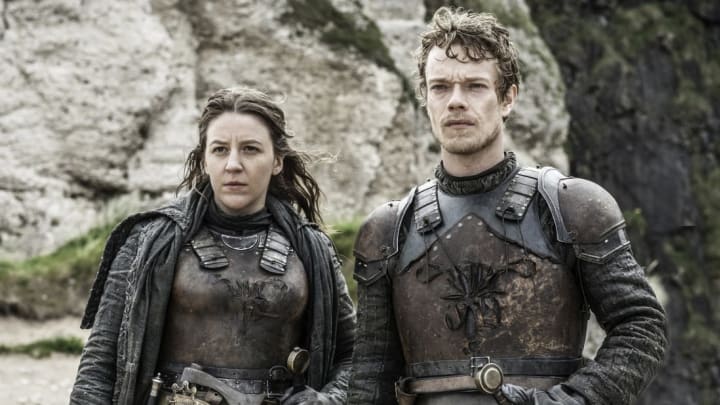7 Historical Parallels to Game of Thrones

When creating his highly detailed fantasy world, George R. R. Martin based much of Game of Thrones on medieval European history. In particular, Martin drew heavily from the War of the Roses; here are seven more possible historical connections.
(Warning: Spoilers ahead!)
1. Joffrey had some things in common with Edward of Lancaster.
As evil as he was, King Joffrey's vicious personality seems to be rooted in history. Edward of Lancaster was the son of King Henry VI and Margaret of Anjou—and, like Joffrey, there were rumors around his parentage. Also like Joffrey, Edward had a touch of madness, and he shared Joffrey’s affinity for lopping off the heads of his enemies. The Ambassador of Milan once wrote, "This boy, though only 13 years of age, already talks of nothing but of cutting off heads or making war, as if he had everything in his hands or was the god of battle or the peaceful occupant of that throne." (Though some have argued that he wasn’t really as violent as centuries of historians have proposed.)
2. Theon Greyjoy's historical equivalent was George Plantagenet, 1st Duke of Clarence.
Theon grew up in Winterfell as a ward to Lord Eddard Stark and a surrogate brother to Robb. Following the outbreak of the War of the Five Kings, Theon was one of Robb’s most trusted advisors. After Robb sent Theon to meet with his father, Balon Greyjoy, Theon turned on his friend and invaded the North.
Theon's historical counterpart, George Plantagenet, was brother to Edward IV of York and, like Theon, began the War of the Roses as a staunch York defender. Much like Theon, George Plantagenet turned on his brother during the War of the Roses and defected to the Lancastrians. Although the brothers reconciled, George was drowned in a butt of wine for treason, which some might say is a kinder punishment than the many atrocities that Theon endured at the hands of Ramsay Bolton.
3. The Red Faith is Zoroastrianism.
In the show (before his death at the hands of Brienne of Tarth), Stannis followed the advice of the “Red Woman,” Melisandre, who worships the lord of light, R’hllor. The faith of the R’hllor appears to be based on the ancient Persian religion Zoroastrianism. In Zoroastrianism, fire is considered a medium for spiritual awareness and wisdom, with worshipers often praying in the presence of fire or in fire temples. Like the followers of The Lord of Light, Zoroastrianism also stresses a great struggle and the duality between good and evil (in the series it is referred to as “The Lord of Light” and “The Great Other”). As of right now, there is no evidence to suggest that demon shadow babies actually existed.
4. Jaime Lannister's historical equivalent is Gottfried von Berlichingen.
In Game of Thrones's season four premiere, Jaime Lannister received a shiny new gold hand to replace the one that was hacked off. The character has a little something in common with Gottfried von Berlichingen, or, as he was also known, "Gotz of the Iron Hand." Like Jaime, Gotz was born to a noble family before serving as an Imperial Knight. During battle, Gotz's hand was blown off by a cannon. Not easily deterred, Gotz designed a prosthetic iron hand and returned to combat. He's well known for his catchphrase, "er kann mich am Arsche lecken" ("he can lick my arse"), which also makes him a precursor to Futurama's Bender.
5. Part of Lyanna Stark's story may have been inspired by Lucretia.
Lyanna Stark was the sister of Eddard Stark and the one true love of Robert Baratheon. Her alleged kidnapping by Rhaegar Targaryen and the events that followed sparked Robert's Rebellion, which landed him on the Iron Throne. Of course, we now know that that version of events was a lie: Lyanna went with Rhaegar willingly—eventually marrying him and bearing him a son, Aegon Targaryen, a.k.a. Jon Snow. But the version of events that Robert believed has a lot in common with Lucretia. She was a Roman figure who committed suicide after being raped by the Etruscan king's son, a tragedy that sparked the revolution to overthrow the monarchy and establish the Roman Republic.
6. The Battle of Blackwater Bay has similarities to The Second Arab Siege of Constantinople.
The Battle of Blackwater Bay—when Stannis Baratheon attempted to sieze the capital of King’s Landing—was the focus of the penultimate episode of season two. Stannis was defeated after Tyrion attacked his navy with wildfire, a chemical that burns even on water. Tyrion might have gotten this idea from The Second Arab Siege of Constantinople, where Greek Fire was used to repel invaders. Additionally, in the books, Tyrion employed a giant chain to cut through Stannis’s navy, which is clearly inspired by the Great Chain of Constantinople, also used in The Second Arab Siege.
7. The Red Wedding has historical parallels in the Kojiki.
Game of Thrones's "Red Wedding" was one of the most shocking moments in TV history. In one move, Tywin Lannister (in collusion with Roose Bolton and Walder Frey) kills Robb Stark and ends the northern rebellion. The Red Wedding is said to be based on two British massacres, but it also draws parallels to an ancient Japanese event that's detailed in the Kojiki, a half-historical, half-mythological text that chronicles the rise of Japan's first ruler, Emperor Jimmu. Part of the Kojiki describes how Jimmu consolidated his power: by murdering a group of his enemies at a feast. Like the Red Wedding, the start of the massacre was a song, this one sung by Jimmu himself.
This story was updated in 2019.